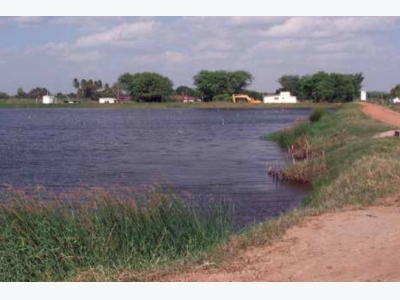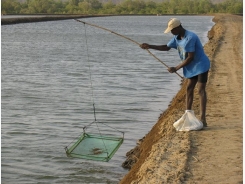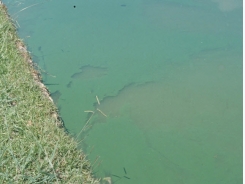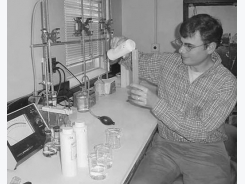Water Composition: Dissolved Inorganic Solids

Interest in inland aquaculture is growing, but inland waters can have ionic imbalances that affect the growth and survival of cultured species.
Summary:
A few anions and cations, and un-dissociated silicic acid represent the largest fraction of dissolved inorganic solids in water. The total concentration of ions is called the salinity. The total dissolved-solids concentration usually is roughly equal to salinity in freshwater. Unlike seawater, freshwater varies greatly in salinity and proportions of individual ions. Calcium and bicarbonate are dominant ions in river water, but sodium and chloride are dominant in seawater. Water contains many other inorganic substances, as well as many trace elements.
In spite of being commonplace, water has a chemical complexity that is seldom fully appreciated. Pure water probably exists only in water vapor – even rainwater contains dissolved substances. Water for aquaculture comes from surface runoff, streams, underground aquifers, reservoirs, estuaries and the sea.
Freshwaters come in contact with soils and other geological formations, and are influenced by climate, so they are much more chemically complex than rainwater. Freshwaters also vary in chemical composition from one location to another. Of course, seawater composition has developed over millions of years, and the ocean is so vast that its composition is similar from place to place.
Water used in aquaculture contains an array of dissolved gases, dissolved inorganic and organic solids, and particulate inorganic and organic solids. The particulate organic solids include both living organisms and their decomposing remains.
All of these substances influence the quality of water for use in aquaculture, but this article focuses on dissolved inorganic solids.
Salinity
A few anions, bicarbonate, carbonate, sulfate and chloride; a few cations, calcium, magnesium, sodium and potassium; and, largely, un-dissociated silicic acid represent the largest fraction of dissolved inorganic solids in water. The total concentration of ions in water is called the salinity and is typically reported in either milligrams per liter or parts per thousand. It is inconvenient to measure the major ion concentrations and add them to obtain salinity.
Salinity can also be measured with a hydrometer, because the density of water increases with greater salinity. Salinity affects the refractive index of water, an effect that allows salinity to be measured with a hand-held refractometer. The ability of water to conduct electricity increases with greater ion concentration, so the conductivity of water provides another way of estimating salinity.
The salinity of freshwater varies from near 0 to 1,000 mg/L. Average seawater contains 34,500 mg/L salinity. Saline inland water and estuarine water can have lower or higher salinity than ocean water. The conductivity of seawater is around 50,000 μmhos/cm, and in seawater and estuarine water, multiplying the factor 0.69 times conductivity provides a reasonable estimate of salinity in milligrams per liter.
Seawater has relatively constant proportions of major ions, but freshwater and saline inland waters do not. The factor for relating conductivity to salinity in these waters ranges from about 0.55 to 0.80. Thus, conductivity is not as accurate for estimating salinity in freshwater as in seawater.
Total Dissolved Solids
The total dissolved-solids (TDS) concentration often is measured in freshwater by filtering water through a 0.45-μ filter, evaporating the filtrate and weighing the residue. The concentrations of dissolved organic matter and unionized substances usually are low, and the weight of these substances tends to be offset by loss of carbon dioxide from bicarbonate when water evaporates.
Thus, TDS concentration usually is roughly equal to salinity in freshwater. Salts are hydroscopic, and TDS concentrations cannot be measured accurately from the weight of the residue after evaporation for waters with concentrations above 2,000 or 3,000 mg/L.
Major Ions
Global average concentrations of major ions in river water and seawater are presented in Table 1. Calcium and bicarbonate are dominant ions in river water, but sodium and chloride are the dominant ions in seawater. Magnesium also is more abundant than calcium in seawater, while the opposite is true in freshwater.
Unlike seawater, freshwater varies greatly both in salinity and in the proportions of individual ions. The lowest salinities are found in humid areas with highly leached, acidic soils, while the greatest salinities are found in areas with limestone deposits and in arid regions. In arid regions, sulfate and chloride often are present in greater concentrations than bicarbonate. This is especially true in saline inland waters, where sodium is often at higher concentration than calcium, and magnesium and potassium often are at low concentrations.
Bicarbonate and carbonate in water often are titrated with standard sulfuric acid and expressed as total alkalinity in milligrams per liter of calcium carbonate. Calcium and magnesium concentrations are often titrated collectively with the chelating agent ethylenediaminetetraacetic acid and expressed as total hardness, also in milligrams per liter of calcium carbonate.
Freshwater fish tend to grow best at salinities of 1,000 mg/L or less, but some species grow well in water with salinities of 5,000 mg/L or even more. Estuarine species such as marine shrimp can grow well across a wide range of salinity – from 1,000 mg/L up to full-strength seawater or higher. Of course, marine species grow best in full-strength seawater.
Table 1. Concentrations of major ions and silicate in world average river water and normal ocean water.
| River Water (mg/L) | Ocean Water (mg/L) | |
| Bicarbonate/carbonate | 58.0 | 142.0 |
| Sulfate | 11.2 | 2,700.0 |
| Chloride | 7.8 | 19,000.0 |
| Calcium | 15.0 | 400.0 |
| Magnesium | 4.1 | 1,350.0 |
| Sodium | 6.2 | 10,500.0 |
| Potassium | 2.3 | 380.0 |
| Silicon as silica | 13.1 | 6.4 |
There is considerable interest in growing marine and estuarine species in inland saline water that is an unused resource in many regions. Sometimes, inland waters have ionic imbalances that affect the growth and survival of culture species, especially shrimp
The most common ionic imbalance is a shortage of potassium that results in an excessive sodium:potassium ratio. Also, magnesium concentration sometimes may be too low. Mineral amendments such as muriate of potash (potassium chloride) and potassium magnesium sulfate can be used to correct ionic imbalances.
Low alkalinity and hardness are associated with acidic water, and liming often is done to increase their values. Alkalinity should exceed 60 mg/L in freshwater fish culture and 100 mg/L in shrimp and other crustacean ponds. The hardness should equal the alkalinity, but greater concentrations are acceptable.
Other Inorganic Substances
Water contains many other inorganic substances. The plant nutrients phosphate, ammonium and nitrate are usually present at low concentrations of less than 0.5 mg/L phosphate-phosphorus, 2.0 mg/L ammonium-nitrogen and 0.5 mg/L nitrate-nitrogen, but these nutrients are extremely important because of their effect on phytoplankton productivity. Concentrations of silicon, an element important for the growth of diatoms, are usually between 2.0 and 10.0 mg/L.
Nitrogen and phosphorus fertilizers often are applied to promote phytoplankton growth in ponds without feeding or during the initial stages of culture in ponds with feeding. Silicon fertilization sometimes is practiced in shrimp ponds to promote diatom growth, but the benefits of this practice are unclear.
Trace Elements
Water also contains a multitude of trace elements. Some, such as iron, manganese, zinc, copper, boron, cobalt, molybdenum and iodine, are nutrients. Others, such as lead, chromium and cadmium, are not nutrients and can be toxic.
Of course, even nutritive trace elements can be toxic at excessive concentrations. Trace elements, particularly iron, are sometimes added to fertilizers for saline-water ponds, because a shortage of iron is thought to limit phytoplankton growth in the ocean.
pH
Water dissociates slightly, yielding hydrogen and hydroxyl ions. These two ions do not contribute significantly to salinity, but pH – which is extremely important in aquaculture – is related to concentrations of these ions.
The pH is defined as the negative logarithm of the hydrogen ion concentration. Pure water has a pH of 7.0 and is considered neutral. The acidity of water increases with decreasing pH below 7, and basicity increases with increasing pH above 7.0. Most aquaculture species do best at a pH between 6.0 and 8.5.
Perspectives
The chemical nature of a water source has a strong influence on the suitability of the water for aquaculture. Therefore, the chemical compositions of water sources for aquaculture should be known and monitored occasionally for possible changes so that appropriate measures may be taken to remediate the water, if necessary.
Functional Diets Improve Survival...

effects in the microbial. Furthermore, the use of an acidifier rather than antibiotics means that there is no chance of contributing to antibiotic resistance in bacteria, nor are there any antibiotic-related effects on the food supply.
The combination of these additives allowed better growth and survival since they were able to improve digestion and kill bacteria efficiently; in addition it proposes a safe strategy to fight Vibrio infections without the risks implied by the use of antibiotics. Nicovita Prevence® should be used 14 days prior to a mortality event to build up the immune system, following its administration Nicovita Terap® should be administered for 14 days if the mortality event is due to Vibrio sp. Alongside the dietary treatment water quality and environmental parameters should be evaluated and adjusted, if necessary, to create a better media for the growth of shrimp and to maximize the potential of the diets being used.
Acknowledgments
Aquaculture Business Research Center (ABCR), Faculty of Fisheries, Kasetsart University, Bangkok, Thailand.
References available from first author
Nicovita´s Veterinary Technical Staff can assist you in any adjustments made to this protocol and according to the type of stocking used in your facility.
Table 2. Protocol for use of Nicovita’s products.
| Direct Stocking | Microbiological analysis Vibrio sp. (Shrimp Larvae) | Growout Period | ||||
| Vibrios < 1*103 CFU/g | Day 0-14 | Day 15-30 | Day 31-45 | Day 46-50 | From Day 51 To Harvest | |
| KR 1/2 | Prevence 1.2 mm | Terap 2.0 mm | Classic 2.0 mm | Classic 2.5 mm | ||
| Vibrios > 1*103 CFU/g | Day 0-14 | Day 15-30 | Use Nicovita Terap as needed according to bacteriological analysis of Vibrio sp. | |||
| Terap 1.2 mm | Prevence 1.2 mm | |||||
Related news
Tools

Phối trộn thức ăn chăn nuôi

Pha dung dịch thủy canh

Định mức cho tôm ăn

Phối trộn phân bón NPK

Xác định tỷ lệ tôm sống

Chuyển đổi đơn vị phân bón

Xác định công suất sục khí

Chuyển đổi đơn vị tôm

Tính diện tích nhà kính

Tính thể tích ao




 Total Alkalinity, Total Hardness
Total Alkalinity, Total Hardness  Anion-Cation Balance: Cross-Check for Reliability of Ion Analyses
Anion-Cation Balance: Cross-Check for Reliability of Ion Analyses